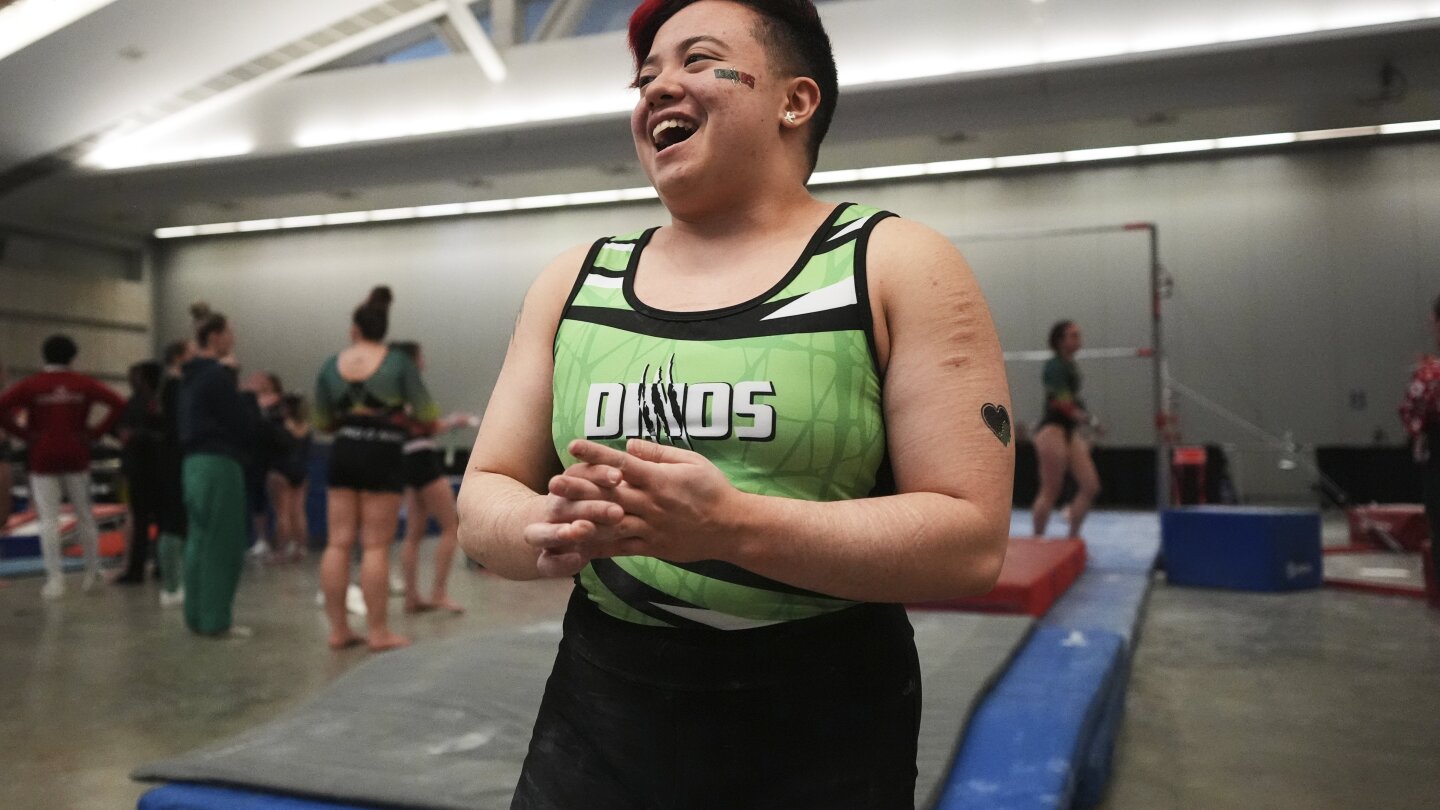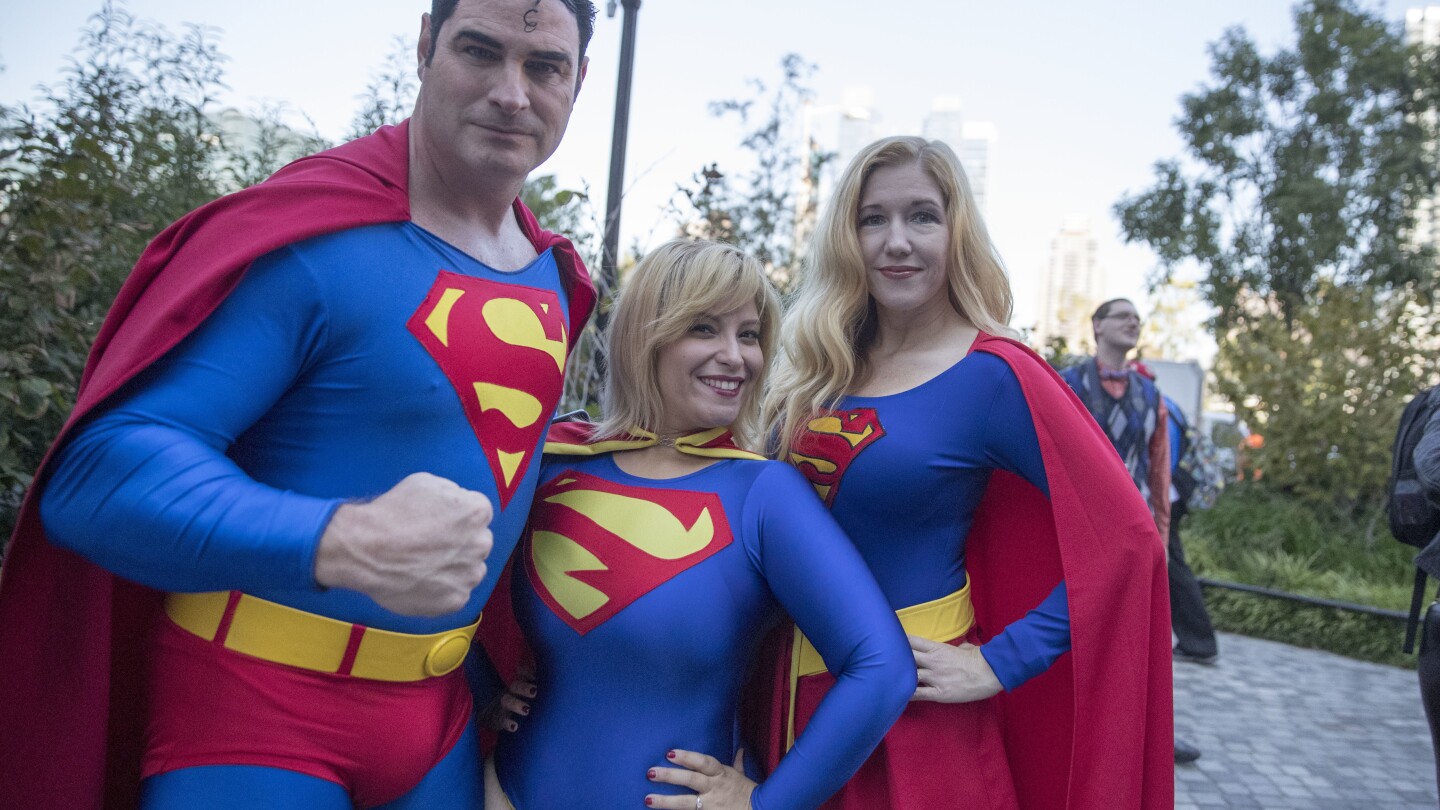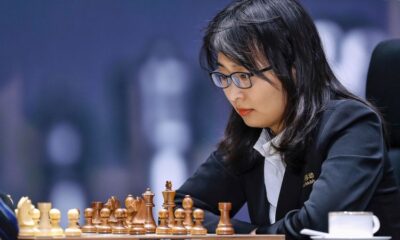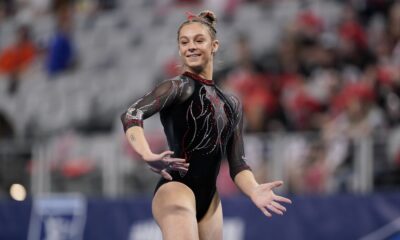Lifestyle
Trans athletes are under more scrutiny than ever. Some have found a safe space in gymnastics

PITTSBURGH (AP) — Raiden Hung can’t imagine a life without gymnastics. And to be honest, he doesn’t want to.
There’s always been something about the sport that’s called to him. Something about flipping. Something about the discipline it requires. Something about the mixture of joy and calm he feels whenever he steps onto a mat.
“It keeps me sane, I guess,” the 21-year-old student at Northeastern University in Boston said. “Gymnastics is the love of my life basically.”
Raiden Hung, of Jurassic Gymnastics in Boston, center left, celebrates with teammate Fay Malay after competing in the floor exercise at the 2025 NAIGC national competition in Pittsburgh, Friday, April 4, 2025. (AP Photo/Gene J. Puskar)
The hours in the gym have long served as a constant for Hung. The one thing he can always depend on. The one place where he can truly feel like himself.
Still, Hung feared he would be forced to give up gymnastics when he realized in his late teens that he was non-binary. He had identified as female most of his life and competed in women’s events growing up. He says he now identifies as trans-masculine.
Part of Hung’s transition included beginning hormone replacement therapy, something he considered putting off over worries that it meant he would no longer be able to compete.
“It was sort of like, ‘Do I have to make a choice?’” Hung said. “And that would have probably been awful for my mental stability, like having to choose between the two.”
Raiden Hung, of Jurassic Gymnastics in Boston, competes on the balance beam at the 2025 NAIGC national competition in Pittsburgh, Friday, April 4, 2025. (AP Photo/Gene J. Puskar)
The National Association of Intercollegiate Gymnastics Clubs gave Hung safe harbor. The stated mission of the steadily growing organization that includes more than 2,500 athletes and 160 clubs across the country is to provide a place for college and adult gymnasts to continue competing while “pushing the boundaries of the sport.”
That includes, but is hardly limited to, being as gender-inclusive as possible.
During local NAIGC meets, for example, there are no gender categories. Athletes compete against every other athlete at their designated skill level, which can run from novice/developmental routines to ones that wouldn’t look out of place at an NCAA Division I meet.
Gymnasts can also hop on whatever apparatus they want. Women on parallel bars. Men on the balance beam. Just about anything goes. At its annual national meet, the NAIGC even offers the “decathlon,” which allows athletes of all gender identities to compete against each other across all 10 disciplines — six in men’s, four in women’s — of artistic gymnastics.
“(We want) people to be able to continue doing gymnastics into adulthood in a way that feels comfortable and safe and supportive for them,” said Ilana Shushanky, NAIGC’s director of operations.
Raiden Hung, of Jurassic Gymnastics in Boston, competes in the floor exercise at the 2025 NAIGC national competition in Pittsburgh, Friday, April 4, 2025. (AP Photo/Gene J. Puskar)
A challenging climate
The approach comes as transgender athletes find themselves the target of increasingly heated rhetoric.
President Donald Trump signed an executive order in February that gave federal agencies wide latitude to ensure entities that receive federal funding abide by Title IX in alignment with the Trump administration’s view, which interprets “sex” as the gender someone was assigned at birth. A day later, the NCAA said it would limit competition in women’s sports to athletes who were assigned female at birth.
The message to the transgender community at large was clear: You do not belong here. Several trans and/or non-binary members of the NAIGC, which is independently run and volunteer-led and does not rely on federal money to operate, felt it.
Calix Hill, a 26-year-old gymnast who identifies as trans-masculine, returned to the sport two years ago following a lengthy break, the fallout of what they described as an abusive environment in the gym where they trained as a child. Hill was going to law school in the South when they began transitioning and said it was not unusual for them to be met with homophobic slurs while walking across campus or being regularly misgendered or singled out by professors.
Multiple trans or non-binary athletes who spoke to The Associated Press said they pondered quitting following last fall’s election, despondent over what at times feels like an increasingly hostile environment toward their community.
None did. One viewed stepping away as ceding power over a part of who they are to someone else. Another pointed to the social aspect of gymnastics and how vital the feeling of acceptance in their home gym was to maintaining proper mental and emotional health.
“Part of my identity is as an athlete and to see myself as strong and able to do hard things,” said Wes Weske, who is non-binary and previously competed in the decathlon before recently graduating from medical school. “I think (gymnastics) really helped my self-image and was just an important part of understanding myself.”
A sense of normalcy
That sense of belonging was everywhere at the NAIGC’s national competition in early April. For three days, more than 1,700 athletes, including a dozen who registered their gender as “other,” turned a convention center hall in downtown Pittsburgh into what could best be described as a celebration.
Not just of gymnastics. But of diversity. And inclusion.
There were no protests. No performative grandstanding. It all looked and felt and sounded like any other large-scale meet. Cheers from one corner following a stuck dismount. Roars from another corner encouraging a competitor to hop back up after a fall.
It felt normal. That’s the NAIGC’s point. Gymnastics is for everyone.
For Hung and the 11 “other” competitors allowed to choose whether to compete in the men’s or women’s divisions, nationals provided the opportunity to salute the judges and stand alongside their teammates while being seen for who they really are.
When Hung dismounted from his uneven bars routine, several members of Jurassic Gymnastics, the all-adult competitive team based in Boston that Hung joined, came over to offer a hug, pep talk or both.
The group included Eric Petersen, a 49-year-old married father of two teenagers who competed on the men’s team at the Air Force Academy 30 years ago. He now dabbles in women’s artistic gymnastics alongside Hung at Jurassic, one of the largest adults-only gymnastics club in the country.
Petersen has heard all the noise about transgender athletes. It does not jibe with the reality he experiences in the gym.
“Certain people want to convince people that this is a big issue and people are losing their (minds),” he said. “But it’s not like that. Other groups can be uptight about that if they want. But in this group, it’s about the love of the sport. If you love the sport, then do the sport and have fun, no matter who you are.”
Ten Harder, of Boston University Gymnastics Club in Boston, warms up before to competing on the balance beam at the 2025 NAIGC national competition in Pittsburgh, Friday, April 4, 2025. (AP Photo/Gene J. Puskar)
Finding their way
Ten Harder got into gymnastics after being inspired by watching Gabby Douglas win gold at the 2012 Olympics. They spent their childhood competing as a woman but became increasingly uncomfortable at meets as they grew older.
“Everyone is, like, fitting into the binary gender roles of being super feminine or being very masculine,” said Harder, 22, now a Ph. D. student at Boston University who identifies as non-binary/trans masculine. “You’re sort of, like, unsure of where your place is and how you can fit into it.”
Harder felt like they had to make their own path. So they did. They connected on TikTok with a non-binary gymnast from the Netherlands and started competing in a uniform that felt more natural, a practice leotard similar to a tank top and shorts. Over the last couple of years, they have run across other non-binary or queer athletes, easing their sense of loneliness.
Ten Harder, of Boston University Gymnastics Club in Boston, dismounts the balance beam at the 2025 NAIGC national competition in Pittsburgh, Friday, April 4, 2025. (AP Photo/Gene J. Puskar)
“It doesn’t have to just be me figuring this out on my own,” they said. “I can work together with all these other people and see how i can build my own space in this really feminine sport.”
While there are times Harder admits they still grapple with feeling self-conscious about their gender identity even around teammates who have become friends and allies, there is also something greater at play.
“I think it’s important to remember that trans athletes are just people, too,” he said. “We deserve to be in the sports that we love. And we deserve to get a chance to compete and do everything just as other people do.”
Harder, who began taking testosterone recently, competed in the men’s-plus division of women’s artistic gymnastics at nationals at their given level. It just felt right. Hung, by comparison, competed in the women’s-plus division at his given level. Also, because it just felt right.
One trans athlete told the AP they decided to enter the men’s-plus division even though they have not started medically transitioning because they wanted to prove they could hold their own anyway.
They did not win. It hardly mattered. For most NAIGC athletes, the results are almost beside the point.
Ten Harder, of Boston University Gymnastics Club in Boston, waits to compete on the balance beam at the 2025 NAIGC national competition in Pittsburgh, Friday, April 4, 2025. (AP Photo/Gene J. Puskar)
An evolving sport
Gymnastics is a difficult, thankless and often physically demanding pursuit. It’s long been considered the domain of the very young, a niche sport whose popularity spikes every four years during the Olympics only to fade again into the background.
That stereotype is changing on multiple levels. Simone Biles, then 27, became the oldest women’s Olympic all-around champion in 72 years in Paris last summer. Interest in women’s college gymnastics is soaring. And the number of adults in the sport is spiking. Community membership in the NAIGC, for example, has doubled since 2015.
Many of those members are like Jennifer Castellano, a 30-something director of investment operations at a firm in Raleigh, North Carolina, who returned to the gym following a long layoff. The last few years have given her a deep appreciation for the community it builds.
When Castellano sees a transgender athlete competing, what races through her mind is not anger, but awe.
“At no point am I ever like, ‘Oh my gosh, like, he’s taken testosterone, like that’s not fair,’ because it’s incredible,” said Castellano, who competes for Triumph Gymnastics in Cary, North Carolina. “To go through that change and to be able to continue to feel at home and to feel welcomed is so important.”
Hung has finished ahead of cisgender women at local NAIGC meets since he began transitioning. Asked if he’s ever received any pushback, he shakes his head and said, “It’s sort of like, ‘we’re just doing gymnastics.’”
As Fay Malay, a non-binary teammate of Hung’s at Jurassic, put it, “there’s so much more to being a human than the bits and parts (we) got.”
That doesn’t keep Hung from occasionally wondering if competing against cisgender women while taking testosterone gives him an edge. An admittedly anxious person, his mind keeps coming back to two immutable facts.
Raiden Hung, of Jurassic Gymnastics in Boston, competes in the floor exercise at the 2025 NAIGC national competition in Pittsburgh, Friday, April 4, 2025. (AP Photo/Gene J. Puskar)
He’s non-binary trans masculine, something he lives with 24 hours a day, seven days a week, not just the handful of hours a year he’s competing. And he’s a gymnast. Hung feels he should be allowed to love both and be allowed to be both.
In what can feel like an increasingly fractured world, gymnastics gives him peace. He’s found a home at Jurassic and within the NAIGC, one that allows him the freedom to compete as he is, not how others want to define him.
He hopes — as do several other trans athletes who spoke to the AP for this story — that the non-binary community within the NAIGC will one day be large enough to have a division of its own. Maybe down the road. Whether that happens or not, he knows he still has a place in gymnastics. And for now, that’s enough.
“It feels like a sort of like, like a safe bubble or like what’s stronger than a bubble?” said Hung, who finished in the middle of the pack in his division. “I don’t know. But it’s like, it definitely feels like … like a shield.”
___
AP video journalist Patrick Aftoora-Orsagos contributed to this report.
___
AP Sports: https://apnews.com/hub/sports
Lifestyle
The 250th anniversary of the Battles of Lexington and Concord opens debate over US independence
NEW YORK (AP) — The American Revolution began 250 years ago, in a blast of gunshot and a trail of colonial spin.
Starting with Saturday’s anniversary of the Battles of Lexington and Concord, the country will look back to its war of independence and ask where its legacy stands today.
The semiquincentennial comes as President Donald Trump, the scholarly community and others divide over whether to have a yearlong party leading up to July 4, 2026, as Trump has called for, or to balance any celebrations with questions about women, the enslaved and Indigenous people and what their stories reveal.
The history of Lexington and Concord in Massachusetts is half-known, the myth deeply rooted.
What exactly happened at Lexington and Concord?
Reenactors may with confidence tell us that hundreds of British troops marched from Boston in the early morning of April 19, 1775, and gathered about 14 miles (22.5 kilometers) northwest on Lexington’s town green.
Firsthand witnesses remembered some British officers yelled, “Thrown down your arms, ye villains, ye rebels!” and that amid the chaos a shot was heard, followed by “scattered fire” from the British. The battle turned so fierce that the area reeked of burning powder. By day’s end, the fighting had continued around 7 miles (11 kilometers) west to Concord and some 250 British and 95 colonists were killed or wounded.
But no one has learned who fired first, or why. And the revolution itself was initially less a revolution than a demand for better terms.
Woody Holton, a professor of early American history at the University of South Carolina, says most scholars agree the rebels of April 1775 weren’t looking to leave the empire, but to repair their relationship with King George III and go back to the days preceding the Stamp Act, the Tea Act and other disputes of the previous decade.
“The colonists only wanted to turn back the clock to 1763,” he said.
Stacy Schiff, a Pulitzer Prize winning historian whose books include biographies of Benjamin Franklin and Samuel Adams, said Lexington and Concord “galvanized opinion precisely as the Massachusetts men hoped it would, though still it would be a long road to a vote for independence, which Adams felt should have been declared on 20 April 1775.”
But at the time, Schiff added, “It did not seem possible that a mother country and her colony had actually come to blows.”
A fight for the ages
The rebels had already believed their cause greater than a disagreement between subjects and rulers. Well before the turning points of 1776, before the Declaration of Independence or Thomas Paine’s boast that “We have it in our power to begin the world over again,” they cast themselves in a drama for the ages.
The so-called Suffolk Resolves of 1774, drafted by civic leaders of Suffolk County, Massachusetts, prayed for a life “unfettered by power, unclogged with shackles,” a fight that would determine the “fate of this new world, and of unborn millions.”
The revolution was an ongoing story of surprise and improvisation. Military historian Rick Atkinson, whose “The Fate of the Day” is the second of a planned trilogy on the war, called Lexington and Concord “a clear win for the home team,” if only because the British hadn’t expected such impassioned resistance from the colony’s militia.
The British, ever underestimating those whom King George regarded as a “deluded and unhappy multitude,” would be knocked back again when the rebels promptly framed and transmitted a narrative blaming the royal forces.
“Once shots were fired in Lexington, Samuel Adams and Joseph Warren did all in their power to collect statements from witnesses and to circulate them quickly; it was essential that the colonies, and the world, understand who had fired first,” Schiff said. “Adams was convinced that the Lexington skirmish would be ‘famed in the history of this country.’ He knocked himself out to make clear who the aggressors had been.”
A country still in progress
Neither side imagined a war lasting eight years, or had confidence in what kind of country would be born out of it. The founders united in their quest for self-government but differed how to actually govern, and whether self-government could even last.
Americans have never stopped debating the balance of powers, the rules of enfranchisement or how widely to apply the exhortation, “All men are created equal.”
“I think it’s important to remember that the language of the founders was aspirational. The idea that it was self-evident all men were created equal was preposterous at a time when hundreds of thousands were enslaved,” said Atkinson, who cites the 20th-century poet Archibald MacLeish’s contention that “democracy is never a thing done.”
“I don’t think the founders had any sense of a country that some day would have 330 million people,” Atkinson said. “Our country is an unfinished project and likely always will be.”
Lifestyle
Sweets from the sky! A helicopter marshmallow drop thrills kids in suburban Detroit

ROYAL OAK, Mich. (AP) — It’s spring in Detroit — warm weather, a few clouds, and a 100% chance of marshmallow downpours.
The source? A helicopter zooming above the green lawn of Worden Park on Friday, unloading sack-fulls of fluffy treats for hundreds of kids waiting eagerly below, some clutching colorful baskets or wearing rabbit ears.
The children cheered and pointed as the helicopter clattered by on its way to the drop zone. Volunteers in yellow vests made sure kids didn’t rush in and start grabbing marshmallows until after the deluge was complete.
For anyone worried about hygiene, don’t fret. The annual Great Marshmallow Drop isn’t about eating the marshmallows — kids could exchange them for a prize bag that included a water park pass and a kite.
The marshmallow drop has been held for over three decades in the Detroit suburb of Royal Oak, Michigan, hosted by Oakland County Parks.
One toddler, Georgia Mason, had no difficulty procuring a marshmallow at her first drop, her dad Matt said.
“Probably the most exciting part was seeing the helicopters. But once we saw the marshmallows drop, we got really excited,” Matt Mason said.
“And, yeah, we joined the melee,” he said, “We managed to get one pretty easy.”
Organizers said 15,000 marshmallows were dropped in all.
The helicopter made four passes, dropping marshmallows for kids in three age categories: 4-year-olds and younger, 5-7-year-olds, and those ages 8 to 12. A drop for kids of all ages with disabilities came later in the day.
“We do it because it’s great for community engagement,” Oakland County recreation program supervisor Melissa Nawrocki said.
“The kids love it,” she continued. “The looks on their faces as they’re picking up their marshmallow and turning in the marshmallow for prizes is great.”
Lifestyle
AP report: Superman comics have religious and moral themes

Superman comics are not overtly religious. Yet faith and morality have been baked into this superhero character who was born Kryptonian, raised Methodist and created by two young Jewish men in 1930s Cleveland.
Superman’s character has been portrayed in the mold of Christ and Moses given how he constantly upholds the ideals of self-sacrifice, powerful leadership and compassion. While scholars, comic book writers and fans alike are struck by the religious undertones in Superman comics, they all agree that what sets Superman apart is his ability to bring hope in a hopeless world.
Superman Day and the ‘Superman’ summer movie release
Friday (April 18) marks the 87th anniversary of the original superhero’s birth. It also is the date Superman made his debut in an Action Comics issue.
There is much excitement in the Superman fanverse this year because of the much-anticipated ‘Superman’ movie directed by James Gunn, starring David Corenswet, the first Jewish actor to play Superman in a major film.
On his Instagram page on April 18, 2024, Gunn shared a photo of himself, Corenswet and Rachel Brosnahan who plays Lois Lane in the upcoming film, reading among several comic books, a reproduction of Action Comics #1 — the very first one featuring the Man of Steel.
In his Instagram post, Gunn also paid tribute to the superhero, saying: “He gave us someone to believe in, not because of his great physical power, but because of his character and determination to do right no matter what.”
Gunn’s film promises a return to a version of a vulnerable Superman who is rooted in values espoused by most faiths — goodness, compassion and hope.
Superman’s Jewish roots
Samantha Baskind, professor of art history at Cleveland State University, is Jewish and sees numerous parallels between Superman’s origin story and the history of Jews.
She says Superman’s solitary flight from Krypton in a small spacecraft is reminiscent of how Moses’ mother placed him in a papyrus basket and left him on the Nile, seeing it as his best chance of survival.
Some also compare Superman’s backstory to the Kindertransport, she said, referring to a humanitarian rescue program that transported nearly 10,000 children, mostly Jewish, from Nazi-controlled territories to Great Britain in 1938 and 1939. In Superman’s Kryptonian name, Kal-El, chosen by his original Jewish creators Jerry Siegel and Joe Shuster, the “El” in Hebrew connotes God.
“There’s also the thinking that Siegel and Shuster created Superman because they were these two, skinny, young Jewish men who couldn’t go out and fight Hitler, but Superman fought Nazis on the cover of their comic books,” Baskind said.
In some early editions, Superman held Hitler by his Nazi uniform as he begged for mercy.
Strong appeal to diverse groups
Superman is relatable to diverse populations regardless of religion, race or ethnicity.
Gene Luen Yang, who has written several Superman comics, sees his own experience as a Chinese American mirrored in Superman’s story — caught between two worlds and two cultures. Yang says he had one name at home and another at school, just like Superman. So, even though he is a practicing Catholic, Yang says he relates more to Superman’s Jewish roots.
Despite the religious undertones, Superman also appeals to those who are religiously unaffiliated, said Dan Clanton, professor of religious studies at Doane University in Nebraska, adding that the superhero’s story “truly encapsulates American civil religion.”
Neal Bailey, a longtime contributor to Superman Homepage, a fan site, is an atheist. He views Superman as a “philosophical pragmatist” with the ability to solve the most complex problems with the least amount of harm.
“He actually goes beyond religion to see our commonalities,” Bailey said. “Superman wouldn’t care about people’s religious beliefs. He would care more about whether they are living up to their human potential.”
Superman inspires humans to do better
Grant Morrison, one of the best-known writers of Superman comic books, said in a 2008 interview that humans become what they imitate, which is why he made Superman an inspirational character.
Superheroes have received less-than-flattering treatment in recent films and television shows. For example, in “The Boys,” a comic book turned Amazon Prime series, the Superman-like character, Homelander, is a government-sponsored hero whose smiling exterior conceals the heart of a sadist. Gunn’s Superman is expected to change that trajectory with a superhero who will reinforce the character’s core value of preserving life at any cost.
An altruistic view of Superman can be found in the recently concluded “Superman & Lois” television series on the CW Network in which after defeating Lex Luthor in a final battle, the couple settles down in a small town and starts a foundation to help others.
“I didn’t just want to be a hero that saves people,” the Superman character played by Tyler Hoechlin says in an epilogue to the series. “I wanted to connect with them. To change their lives for the better.”
___
Associated Press religion coverage receives support through the AP’s collaboration with The Conversation US, with funding from Lilly Endowment Inc. The AP is solely responsible for this content.
-

 Conflict Zones2 days ago
Conflict Zones2 days agoHaiti in ‘free fall’ as violence escalates, rights group warns | Armed Groups News
-

 Lifestyle2 days ago
Lifestyle2 days agoBelievers say microdosing psychedelics helps them. Scientists are trying to measure the claims
-

 Sports2 days ago
Sports2 days agoJu Wenjun: Chinese grandmaster makes history by winning fifth Women’s World Chess Championship
-

 Middle East2 days ago
Middle East2 days agoHamas accuses Israel of weaponising aid as Gaza’s hunger crisis worsens | Gaza News
-

 Lifestyle2 days ago
Lifestyle2 days agoPicking a team from bars to beam and hoping for 10s: Fantasy leagues in gymnastics are a thing
-

 Middle East2 days ago
Middle East2 days agoPalestinian photographer Samar Abu Elouf wins world’s top photo prize | Gaza News
-

 Sports2 days ago
Sports2 days agoArsenal reaches first Champions League semifinal in 16 years, with Inter Milan also advancing
-

 Africa2 days ago
Africa2 days agoEuropean Union announces new asylum measures



